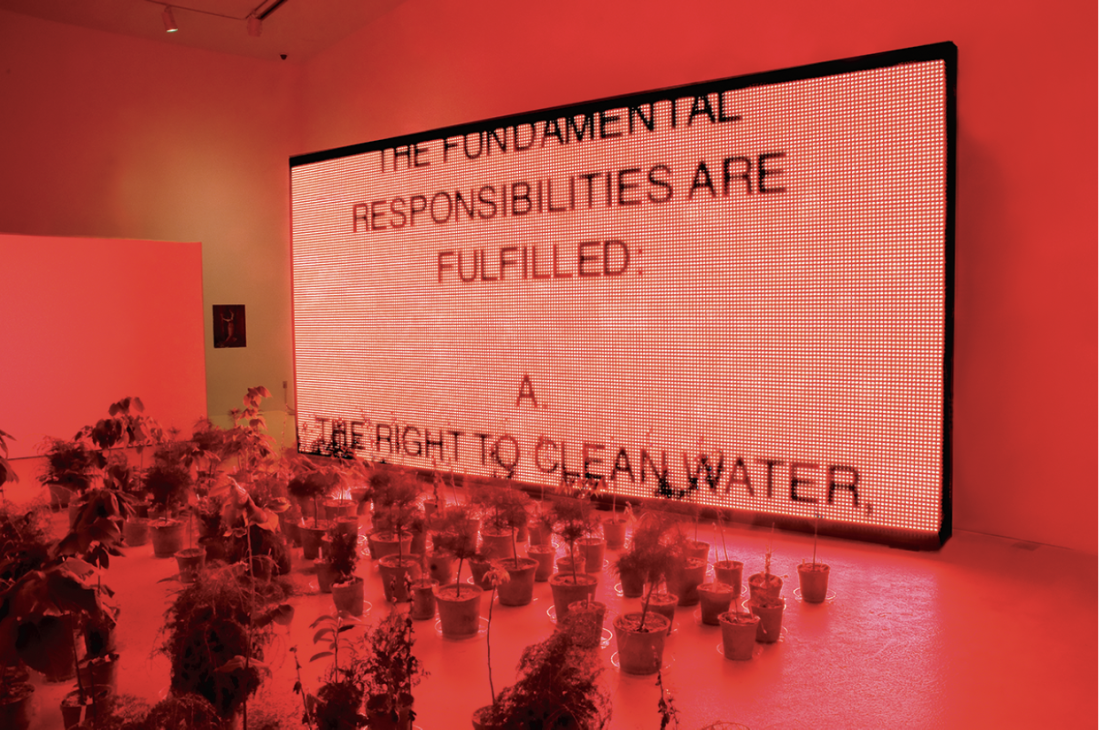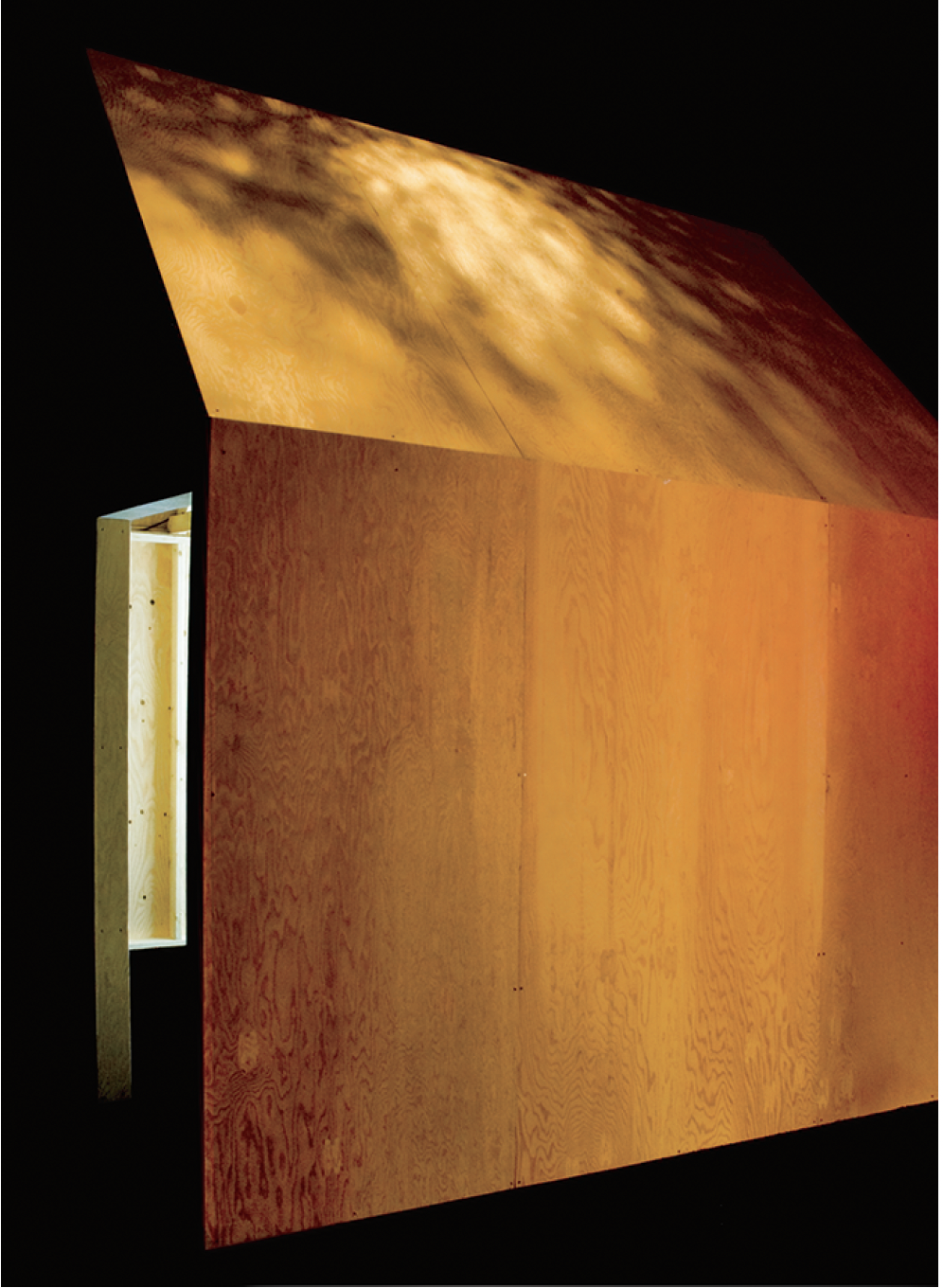Public Studio
A standout exhibition in the 2016 CONTACT Photography Festival, Public Studio’s transformation of the Art Gallery of York University was both sensorially and intellectually thrilling, and highly relevant to our times. Public Studio is filmmaker Elle Flanders and architect Tamira Sawatzky. Since 2009 the Toronto-based duo has made installations, films and socially engaged projects centring on public space. The work is incisive and politically engaged, but with a lyricism and aesthetic power that draws the viewer in, creating space for both pleasure and complex ideas. Focusing on the fraught relationship we’ve had with the natural world since the Enlightenment (epitomized by the idea of the forest), “What We Lose in Metrics” is no exception.
The gallery is entered via a long dark corridor, with black netting overhead holding subtly lit leaves, suggesting a nighttime forest canopy but also the camouflage netting used by the military. We make our way out to a clearing: a huge projection of a cedar forest wraps around two walls, and the wall behind us is mirrored—so we see ourselves within these woods. Leaves sway in the breeze, but the trees are impassive, the space is like an immersive stage that only we ourselves can activate or project meaning onto. On the right a large plywood structure in the classic shape of a cabin in the woods juts out of the wall. This cultural symbol is laden with associations, from horror films (e.g., the Joss Whedon feature of that very name) to the romantic literature of Thoreau. The structure also evokes the witch’s house, or Grandma’s, in numerous fairy tales. All these tropes, and many more, wherein the tension between nature and culture plays out, are deeply gendered, and this is something that the artists have carefully woven throughout the works.

Public Studio, installation view, “What We Lose in Metrics,” 2016, Art Gallery of York University, Toronto. Photo: Cheryl O’Brien. Images courtesy the artists and the AGYU.
Inside the wood cabin the video piece The Darkness Between Lives, 2016, cuts together monochrome footage of forest scenes from films like Bambi, Avatar, Apocalypse Now, Evil Dead and Aguirre, the Wrath of God. The soundtrack to this piece, by regular collaborator Anna Friz, permeates all areas of the labyrinthine exhibition, dirgelike, insistent and laden with dread. We see the romanticization, exploration and destruction of the forest and the Other associated with it (women, as well as Indigenous peoples and animals). What is revealed is the bloody violence that lies beneath the rhetoric of progress and nature as a resource. This is a story that echoes painfully from the enclosure of the commons in 18th-century England, colonial expansion and the scientific revolution, right through to the advanced capitalism of our own digital age—more disconnected from nature than ever, and finally at an environmental crisis point.
Throughout the twists and turns of the virtual forest, Public Studio created small monitors with headsets showing imagery from various computer games set in forest locales. The voices of female gamers guide us through these worlds— often taking us off the path, subverting the game functions and choosing to explore the landscape rather than complete the quest or kill the bad guys. Simply the choice to feature women gamers evokes the Gamergate controversy, and questions about the gendered environment of the Internet. The players speak of their varying encounters with forests and their feelings toward the games; the audio feels intimate and idiosyncratic, while connecting individual experiences to wider concerns. Their backgrounds range from a woman who has grown up in the city, and knows she wouldn’t be able to stay for a long time in the forest but feels very safe in this virtual one where she loves to watch the leaves falling, to childhood memories of climbing the tallest tree and building woodland forts. The issue of safety and entitlement to space is alluded to again and again, and really brought home when one woman explains how only recently the forest took on menacing effect when there was a spate of attacks on women in the woods near her home.

Public Studio, installation view, “What We Lose in Metrics,” 2016, Art Gallery of York University, Toronto. Photo: Cheryl O’Brien. Images courtesy the artists and the AGYU.
I’m reminded of the Alec Soth retrospective I saw last year, “Gathered Leaves,” particularly the series “Broken Manual,” 2006– 2010, and the film Somewhere to Disappear, 2010. According to the film’s website, it explores “men who live on the margins of society. People who ran away from their natural environment to find their own world.” That exhibition struck me as very masculine, I felt excluded from this romantic idea of returning to the land, and subtly threatened by the worlds I was seeing, because when you have to call a safe-walk program to get from your house through a wooded area to the convenience store, you have a very different relationship with that land. The game walk-throughs are interspersed with the women reading poems selected by the artists, and American poet Anne Sexton’s “Her Kind” illuminates how, while the man who retreats to the wilderness is a visionary or a poet, the woman who does so is a witch: “A woman like that is not a woman, quite / I have been her kind.” As well as gender, the game worlds and those who traverse them address the genocide and oppression of Indigenous peoples and the (continued) expropriation of their land.
Finally, in the exhibition, we emerge from the dark corridor of screens to a large white space pulsing with changing light, and full of saplings. This light is cast by a giant bank of coloured LED bulbs, which form the scrolling words of a manifesto. Written for the exhibition by Haida lawyer Terri-Lynn Williams-Davidson, this text proclaims the “Rights of Nature.” It reads like a charter for the future, one that must be adopted in order for us to actually have a future.
The potted saplings are a selection designed to flourish by biochemist and botanist Diana Beresford-Kroeger, as part of her bioplan to reforest and heal the Earth—a tangible practical recipe for the future. After the exhibition Public Studio will plant the 120 saplings on the AGYU campus, bringing together artists, academics and operations staff to do so, thus putting the ideas and emotions of the exhibition into action, literally at a grassroots level. ❚
“What We Lose in Metrics” was exhibited at the Art Gallery of York University, Toronto, from April 13 to June 19, 2016.
Clare Samuel is a Northern Irish and Canadian artist, writer and educator based between Toronto and Edinburgh. Her work has been exhibited and published internationally. She is currently teaching at Ryerson University and OCAD.

